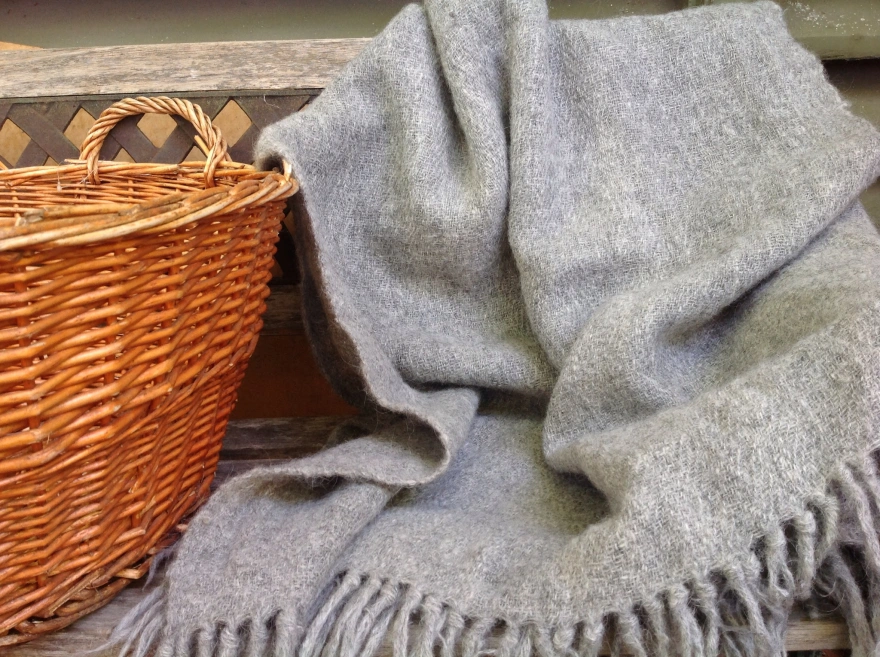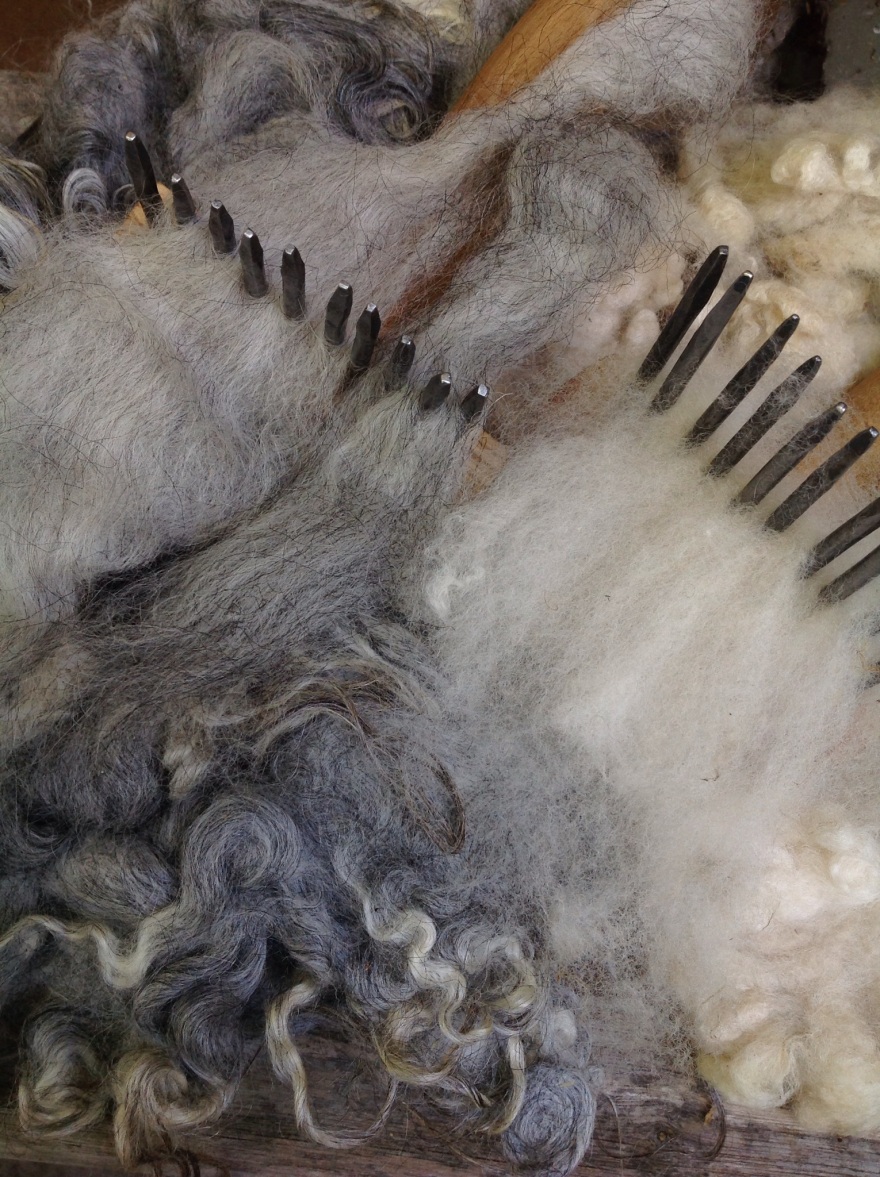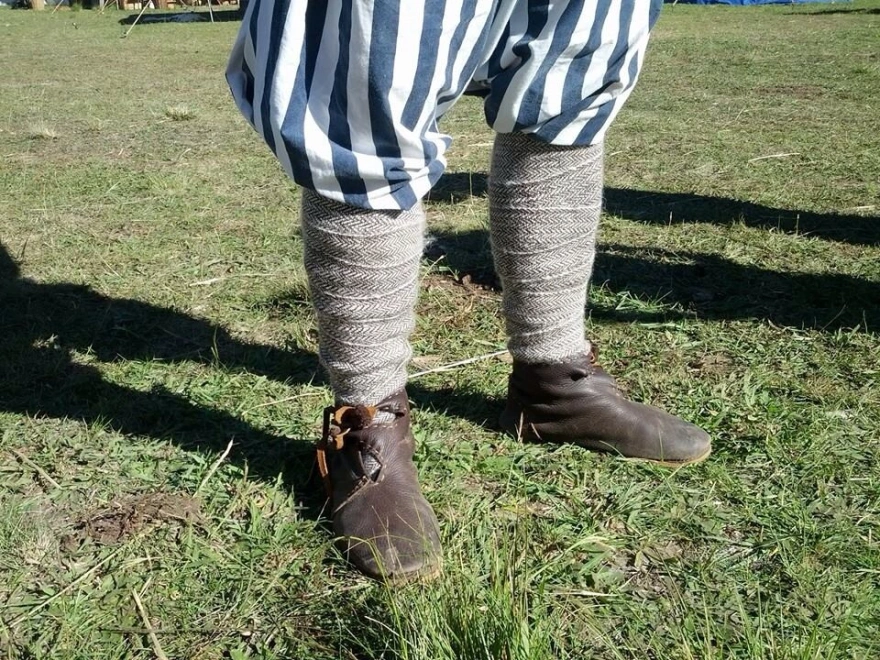Getting wool from local sheep in Australia which the Vikings may have worn around 700AD onwards isn’t viable. Our breeds of sheep are very well up the evolutionary line. The first breeds of sheep documented in Australia were only arriving in the late 1700s http://www.sl.nsw.gov.au/discover_collections/history_nation/agriculture/produce/wool/ and were Spanish Merinos and South African fat tailed sheep. To my knowledge there are none of the Swedish or Norwegian Ancient breeds here but there are some Finn sheep. (I would love to here from any sheepy people who are raising ancient breeds because I would probably want your wool ) So what was a girl into ancient vikings from Staraya Ladoga http://en.m.wikipedia.org/wiki/Staraya_Ladoga in 700AD to do?
I was pretty sure the wool was going to be a heck of a lot different from what the modern world appreciates as wool and many Aussie re-enactors and living history people and I was quite right. Below is a picture of Spelsau Wool and Merino wool after they have been washed and then after they have been combed. The Merino is the lighter, finer wool. 
If you are serious about accurate living history you really have to think about the wools that were around at the time and I set out to look into this area which seems to have been neglected all the way down here in the Southern Hemisphere amongst those interested in this educational hobby. I don’t think people mean to, I just don’t think anyone stopped to think about the breeds of wool around in their chosen time periods. For many, wool is wool and they are unaware or unconcerned about the providence of their wools. I sat down and thought that perhaps I could do some of the leg work and some of the hard yards and even make these more accurate fibres available. I sat down to write this to introduce the subject and damn the torpedoes. I’ve got a much longer journey ahead and I would appreciate your help.
So the first ancient breed I was able to get some wool from was the Icelandic sheep. http://en.m.wikipedia.org/wiki/Icelandic_sheep Evidently this breed has been in Iceland since the Vikings bought them there. It’s a long way from Staraya Ladoga. It’s a long way from anywhere but the creatures have not had too much chance to interbreed with other sheep breeds however they arrived much later than the 700s from what I have read. It’s an interesting hairy wool and spins very nicely on a drop spindle but wasn’t quite my period, I noticed they descended from sheep in Norway but I put that on the back-burner. I Nålebinded http://en.m.wikipedia.org/wiki/Nålebinding some socks http://www.joanna-molloy.com.au/Joanna_Molloy/Viking_Socks.html with it and I made viking leg wraps with it which sold on ETSY as soon as I put them there. Here is a picture of them
Next I tried to get some Russian sheep wool, the type I could find was Romanov sheep http://en.m.wikipedia.org/wiki/Romanov_sheep and I am not really sure how long this breed has been in Russia it seems they were only noticed in the 1800s. Not helpful. Not enough info and I can only translate so much Russian Cyrillic with Google translate. Still not happy but I played around with it, spun it on a drop spindle and then woven it on my floor loom into a beautiful shawl. Which is up on ETSY https://www.etsy.com/au/listing/200178406/earth-shawl? for those interested.
Then I found a lady from Norway who was able to provide me with Old Norwegian Spelsau http://en.m.wikipedia.org/wiki/Spælsau and wild Norwegian sheep wool. This is another very interesting hairy wool that spins well and has long hair and wooly fibres. I spun a whole swag of that on my drop spindle and then wove a herringbone patterned shawl out of that. This one is not on ETSY its in my living history kit and comes out for exhibitions. Im rather proud of it. It is pictured here.

I really am pretty happy with this wool, but its not from Sweden, and there seems to be evidence that Vikings who were hanging out in Staraya Ladoga were most likely Swedish.
I have been patiently waiting for a Swedish contact to move house and get back to me as she knows someone who has ancient Gutefår http://en.m.wikipedia.org/wiki/Gute_sheep sheep and may be able to provide me with some, that will probably be the closest wool I can get to something that may have been worn by Swedish Vikings in Staraya Ladoga around 700AD. Phew. Mad I hear you say, well just a bit :). I really want to know what the wool and the fabrics were like.
I also inadvertently came across another reason why people doing re-enacting and living history might look at their woollens more closely. If there is no demand for supply, these ancient breeds will die out. I recently purchased a DVD from a fibre lady, Debra Ronson, to supplement my interest in ancient wools. She has made a little video promoting her DVD but she pretty much sums up the importance of rare wools as passionately as I would have to say on the matter so I will let her explain it to you here. http://youtu.be/zG8-zx3gt4M



Great article 🙂 The Gotland Sheep have the most luxurious wool! If you haven’t found a supplier yet then maybe any of these adresses can help http://www.gutefar.se/annonser.asp#5
LikeLike
Oh Liv, that is really great. I very much want to get some of the Gutefar wool. I know that they are on Gotland island along with a much later period sheep called the Gotland sheep which looks totally different but is bred from crossing the Gutefar with a bunch of other sheep- trying not to get too confused, I really want the older, more ancient one. I very much appreciate the links you have sent.
LikeLike
Is it the grey, curly breed you want? The one Stansborough used for the fabric in the elven cloaks in Lord of the Rings?
LikeLike
No, that is the later period sheep. There is the Gotland sheep and the Gutefar sheep, two distinctly different breeds. The Gutefar is the older one. This is basic info about the Gotland http://en.m.wikipedia.org/wiki/Gotland_(sheep) and this is basic info about the Gutefar http://en.m.wikipedia.org/wiki/Gute_(sheep). The pictures show how different they are and it talks about their history. I had the same confusion originally.
LikeLike
Oh I guess there is much confusion about this then…I always got the impression that the grey were Gutefår. (btw your layout seems not to allow me to answer to your actual comment)
LikeLike
Yes the confusion is quite understandable. Hmm. Thanks for letting me know about the layout problem. I’ll see what I can do to fix it. Still fairly new to WordPress.
LikeLike
It seems that if I reply from the link in my reader I can do it…but when i go to your blog there are limitations to the number of replies I can write to a comment. I’ve blogged on this platform since 2009 and I fiddle about with layouts as soon as they are launched. I use Oxygen for the reenactment group and have been doing that for ages cuz it realy is the best one for our needs. I use Sketch for my portfoilio and Hatch for my personal blog. I used to blog at Blogspot but moved because I like the WordPress software so much better 🙂
LikeLike
I changed the blogs entire format, has that helped any? If not I will go through the dashboard and see what else I can do to get it working better.
LikeLike
Reblogged this on StraumEyjar and commented:
Great article about wool hunt in Australia 🙂
LikeLike
Thanks so much.
LikeLike
Sounds like you need a holiday in Scandinavia. I haven’t been to Gotland but would love to go, for all the Viking history there.
LikeLiked by 1 person
I would love a holiday in Scandinavia!
LikeLike
In the meantime you might want to check this out. http://granitehavenllamas.com.au/ They raise Gotland sheep in Victoria and are having an open day in November.
LikeLiked by 1 person
Thanks for letting me know that there are some of this later breed in Australia. I was not aware of this and I will most likely be getting some of their wool for other more modern projects. They are descended from the Gutefar or Gute sheep crossed with some other breeds. Because the Gutefar/Gute sheep and the Gotland sheep are both found on the island Gotland initially, there seems to be some confusion. This is the breed that I can spin hobbit cloaks out of 🙂
LikeLike
Herdwick is period for British vike/danelaw, as are soay and black welsh. Herdwick is pretty rough and kempy but make brilliant outer garments, black welsh is fluffier and the colour is the most glorious chocolate brown. George wiel in the uk sell Herdwick and black welsh as tops and fleece( fleece they only have at certain times of year) but I don’t know if they export. I’m not home at the mo but if you remind me next week I think I have a handful of each I can send you if you paypal me the postage.
LikeLiked by 1 person
Sounds like a plan. Would love to see and feel these British Viking/Danelaw fibres. Thank-you so much for your offer. I would be happy to paypal you the postage.
LikeLike
My email should show up on your dashboard comments, remind me during the week
LikeLike
Will do. Thanks again!
LikeLike
I got gutefår and live in Sweden. We got à FB Group there i got à link. Get in touch if you Arne interested in wool.
LikeLike
Hi there. This is great! What is the name of your facebook group so that I can go and find the group and the link?
LikeLike
I have Gute and Gotland sheep and one faroesheep, make yarn and seld wool. BR Hanna http://www.vildmoselam.dk
LikeLike
Dear Hanna, That is great. Looking at your website now!
LikeLike
Hi Hanna, Thanks for letting me know about your Gute sheep and your Faroe sheep. I have sent you an email about the Gute. I have done a little reading about the Faroe sheep now and I think I am interested in that sheep too. I have found some Gotland sheep in Australia since writing my blog but Gute and Faroe are not here. Please email me with your prices.
LikeLike
FYI Iceland was settled (that is the official date of the actual first farming homestead by Ingolfur Arnarsson in Reykjavik) in 874 from Norway, Demark and Sweeden. They brought sheep with them, without them they would have starved. So Iclandic sheep basically date from that time.
LikeLiked by 1 person
Excellent information, thankyou 😀
LikeLike